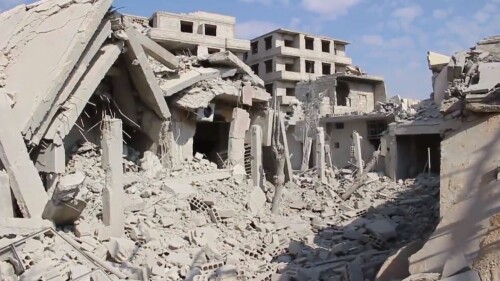ATEQ, YEMEN—Driving from Aden to Ateq, the capital of Yemen’s Shabwah Governorate, takes cars, trucks, and buses past Wadi Omran, which was once ground zero in the fight against Al Qaeda in the Arabian Peninsula.
What I Saw in Southern Yemen
The road is pockmarked by the scars of earlier car bombs and improvised explosive devices. Our driver casually pointed out bullet-pockmarked and burnt-out schoolhouses and compounds where Al Qaeda had attacked the billeted Shabwani Elite forces, killing dozens each time. Every checkpoint had posters of the martyrs who died manning it.
Such an atmosphere requires a sense of security. Aden has it, even though no foreign soldiers patrol the streets of the South Yemeni capital.
Today, though, Ateq is peaceful. So too is neighboring Abyan that sits between Aden and Shabwa, a province Yemenis long considered their version of Appalachia—poor, dangerous, and tribal. The Local Shabwa Defense Forces man checkpoints. They are polite and relaxed but deceptively astute. Superior officers watch them via closed circuit cameras. The Southern Transitional Council’s intelligence service provides tips about the movement of contraband and terrorists; recently, for example, the checkpoints confiscated captagon pills hidden below bullets in AK-47 magazines. In Abyan, where tribal ties are strong, soldiers focused on Yemenis from outside the region to ensure each had a reasonable reason for being in the area; if drivers appeared nervous or evasive, it was easy enough to search vehicles. It might be manpower intensive, but it works.
Summer in Aden is brutal. Temperatures soar upwards of 110 Fahrenheit, and Aden’s humidity can make Washington, DC, seem like Phoenix, Arizona, by comparison. Many stores stay closed until around 4 pm, but then the city comes alive after the sun goes down and the sea breeze starts.
The streets remain crowded until the early hours of morning, with kids playing football, foosball, or even billiards on the street, adults gossiping, and young teens challenging old men to dominoes while imams urge people—often unsuccessfully—to come to the mosque for prayer time. Such an atmosphere requires a sense of security. Aden has it, even though no foreign soldiers patrol the streets of the South Yemeni capital.
A Changed Atmosphere
Since the United Arab Emirates scaled back its presence in Aden in 2019, Western pundits and Pentagon analysts predicted the Southern Transitional Council would struggle to maintain control, let alone repel any offensive by the Iran-backed Houthis, Muslim Brotherhood-supported terror cells, and Saudi- and Omani-supported tribal militias. Six years later, though, the Southern Transitional Council has not only consolidated security, but has expanded it. Just as the U.S. intelligence community underestimated Ukraine’s ability to withstand Russia’s initial onslaught, both the Defense Intelligence Agency and Central Intelligence Agency seem to have underestimated the Southern Transitional Council’s ability to fight.
While Yemenis welcomed President Donald Trump’s 51-day bombing campaign against the Houthis, many Southern Yemenis saw it as a wasted opportunity since the United States did little to coordinate with groups like the Security Belt Forces and other southern groups that do most of the ground fighting.
Diplomatically, Washington neither coordinates effectively nor will the Internationally-Recognized Government’s backers recognize the insincerity of Saudi Arabia and Oman’s commitment to defeat the Houthis.
Without air cover, however, the southern forces have repelled Houthi attacks along some of Yemen’s most volatile and strategic frontlines for several years. I climbed to the peak of a mountain with the commanding general in the Al-Dhale along the traditional North Yemen-South Yemen border to survey the frontline with the Houthis in the valley below. Southern forces have held the line through years of near daily clashes, using local knowledge, trench warfare, and community-driven mobilization to resist well-armed Houthi units.
In Lahij and Yafa’a tribal regions, Southern Transitional Council-affiliated forces have thwarted repeated incursions into mountainous regions that the Houthis once used as gateways for northern offensives.
With minimal cover, the southern forces could drive the Houthis further back. Today, the problem is less military than it is diplomatic and political. Diplomatically, Washington neither coordinates effectively nor will the Internationally-Recognized Government’s backers recognize the insincerity of Saudi Arabia and Oman’s commitment to defeat the Houthis. Politically, the Presidential Leadership Council is incapable of governing any liberated territory as some coalition members prioritize undercutting southern success over defeating the Houthis and Islah—Yemen’s Muslim Brotherhood group—acts as a Trojan Horse for the Houthis. Southern forces can fight and win—especially if given airpower—but a northern group opposed to the Houthis must fill the vacuum.
The southerners sustained resistance without modern air defense systems, armored reinforcements, or large-scale foreign funding. In contrast, the Houthis benefit from an international support network, receiving weapons, drones, and training from Iran, intelligence, logistics, and diplomatic cover from both Oman and, increasingly, Iraqi Shi’i advisors as well. Russia and China provide support in global forums like the United Nations Security Council.
Facts on the Ground
In Aden, I spoke to the region’s military leaders. They were seasoned professionals, many with decades of combat under their belts, first with the People’s Democratic Republic of Yemen, then with post-Cold War unified Yemen, and then with the fight against the Houthis. They had sacrificed, some family members assassinated in retaliation by Islah, Houthi, and Al Qaeda terrorists; one had lost an arm at the front.
While American pundits hand-wring and say that southern Yemenis cannot effectively fight, this reflects more strategic laziness if not defeatism on Washington’s part than a recognition that 2025 is not 2015.
Their needs would cost about an day’s equivalent of what the West provides Ukraine. They seek reconnaissance and combat drones with tactical and operational range; jamming systems against enemy aircraft and combat drones; light and medium weaponry, sniper rifles; small patrol boats to protect coastal regions against Iranian and Omani weapons smuggling; transport vehicles; engineering equipment for mine and unexploded ordinance clearance; both ordinary and night vision binoculars; and a communication system that can bypass the continued Houthi control over Yemen’s cell phone network. Coordinated U.S. aircover would be a game-changer.
Bombing alone cannot defeat the Houthis; only a coordinated ground campaign can. Fortunately, this need not involve American or, indeed, any foreign forces. While American pundits hand-wring and say that southern Yemenis cannot effectively fight, this reflects more strategic laziness if not defeatism on Washington’s part than a recognition that 2025 is not 2015. Either way, the choice for the Trump administration is stark: Defeat the Houthis or double down on failed strategies that enable the Houthis to thrive and their threat to grow.
Published originally on July 27, 2025, under the title “The Pentagon Predicted They Might Collapse. Six Years Later, South Yemen Is Winning (I Was on the Ground).”








